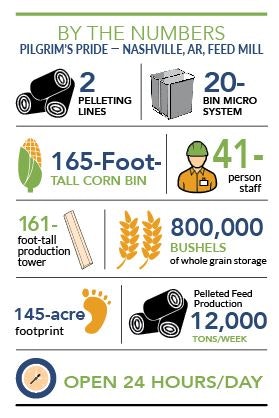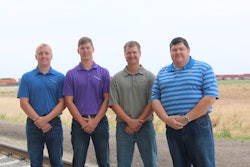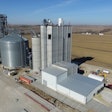Wayne Farms LLC recently embarked on the final piece of a $200 million investment project in southern Alabama with the construction of a 49,000-square-foot poultry feed mill in Ozark with a production capacity of 25,000 tons/week.
Wayne Farms is a vertically integrated poultry operation (the sixth largest poultry producer in the United States, producing a little more than 2.5 billion pounds annually) with 11 fresh and prepared foods facilities throughout the Southeast.
The new mill — the nation’s largest start-up feed mill — represents $55 million of that investment, and was needed to support the production of three nearby fresh chicken processing plants in Union Springs, AL, Jack, AL and Dothan, AL. Thanks to growing demand for poultry worldwide, its Dothan location has grown from 750 employees when Wayne Farms purchased the plant six years ago to 1,000 employees today — processing 1.3 million 4-pound birds a week.
In order to meet this growing demand, in 2014 Wayne Farms’ leadership began planning to modernize its feeding operation by building one state-of-the-art mill to replace its three aging feed mills in Troy, AL, DeFuniak Springs, FL and Enterprise, AL.
“Our vision as we grew in Southern Alabama was to build something centrally located among those three processing plants and get on the CSX main line,” said Brad Williams, area complex manager, Wayne Farms. “It’s more efficient to operate one large, fully automated mill than the three mills that had been in business for quite a number of years.”
Massive yet flexible
Wayne Farms chose the design/ build/engineering firm Todd & Sargent, Inc. to build the slipformed concrete facility, which is essentially two feed mills in one for nimble production flexibility.
Construction crews broke ground in August 2015. Some areas were still under construction as of May 2017, but are expected to be completed before harvest 2017. However, even under construction, the facility began producing feed in February and serves more than 500 farms in the southern Alabama region. At the time of this writing, Wayne Farms had decommissioned two of the locations the Ozark mill will replace. The third will no longer be used by early summer 2017.
The massive complex is capable of producing up to 15 different feed types with its dual batching systems and three 90-ton/hour pelleting systems. The facility stands 232 feet tall and boasts 1 million bushels of bulk corn storage, 4,200 tons of soybean meal storage, and two DDGS silos — one 1,300- and a 1,250-pound DDGS silo and one pound.
“It is the largest start-up feed mill in the country,” said Frank Singleton, media relations, Wayne Farms LLC. “There are larger feed mills that were built years ago and expanded since, but this is the largest new feed mill in the United States.”
Other key mill features include:
- Three receiving systems: rail receiving for corn at 50,000 bushels/hour; rail receiving for soybean meal at 350 tons/hour; truck receiving at 14,000 cubic feet/hour
- 90-car grain loop with 80-car ladder track soft stock storage
- 1.4-mile loop track with 3.2 miles of total track
- Dual batching systems rated at 162 tons/hour and three 90-tons/hour pelleting systems
- Dual truck load-out bays with 3,000 tons of storage/bay
- Dedicated scale house with robotic sampling arm for incoming and outgoing ingredients
- Dual 10-ton mixers
- Two 20-bin microingredient systems
Rail and receiving
The facility requires up to 27 million bushels of corn annually, with 3 to 4 million bushels coming from growers in Alabama, Georgia and Mississippi. It receives about 80% of its corn and soybean meal in unit trains, while 20% is received by truck. Singleton said it takes crews six minutes to unload a 26- to 27-ton truckload of corn.
The loop track was built to accommodate 100-car unit trains, but CSX only operates 90-car units in the region, which a contracted two-man crew can unload in about 12 hours.
The receiving house consists of three pits: one for trucks, a combo truck/rail pit and a rail pit for corn.
“We have ladder tracks for our soft stock, and the rail loop itself is 1.4 miles around,” said Williams. “And we have a combo pit so that we can easily unload and handle DDGS and other issues we come across when the weather is warm.”
Wayne Farms worked closely with CSX to ensure its rail operation would run smoothly. Williams spoke highly of their relationship.
“We had a long relationship with CSX prior to building the mill,” said Williams. “We worked with them on locations along their main rail system even prior to the purchase [of the site] to make sure our plan would work, so they’ve been a valuable partner through the whole process.”
Two mills under one roof

“The mill has two mixers, but also the ingredient bins and the scales are doubled, so you have two sides in the mill that all come into three lines of production with two separate load-out bays,” said Singleton.
This design allows Wayne Farms to produce veg-based feed and traditional feed at the same time, as well as different types of diets within those two designations.
“We produce starter, grower, finisher, WD and WD2, as well as breeder feed here, so flexibility is crucial,” said Williams.
Pathogen control is also a concern, but Jimmy Frazier, South Alabama feed mill manager, Wayne Farms, noted that mechanically there’s no way to cross contaminate because of the facility’s Beta Raven automation system.
“With auto-routing, when the receiving operator receives an ingredient, it has a certain code,” Frazier said. “The program recognizes the code and what bin it’s assigned to, so it automatically routes it to that system. Once the truck driver pulls the feeding load out, the load-out ticket he selects has a code and the system knows what bin that product is in and moves the lorrey system to that spot and loads the truck.”
Currently, Wayne Farms delivers 110 to 120 truckloads of feed/day, and management plans to install an RFID reader system to further enhance pathogen control.
“[Once implemented] the truck will have a bar code on it, and when that truck enters the load-out bay, if it’s not an authorized vehicle for that bay, the system won’t let him load out,” Frazier said. “That’s a process to keep our veggie feed and antibiotic feed separate on the feed trucks, and the automation is the key to that control.”
Local involvement
Today Wayne Farms exports about 6% of its production to Armenia, Bahrain, China, Iraq, South Korea, Mexico, Russia, Singapore and United Arab Emirates, but that number is poised for growth as poultry demand overseas increases. Recognizing this potential growth is part of what spurred such a significant investment in southern Alabama.
“We’re a worldwide company, but I would say 60% of Wayne Farms’ production is grown in Alabama, with 45% just in south Alabama,” said Singleton. “If we wanted to grow, we had to invest here locally.”
Known as the wiregrass region, the area is focused on economic development, and the community welcomed Wayne Farms’ new feed mill with open arms.
“From the infrastructure, to the public and the private sectors working together and to the Alabama Department of Agriculture and Industry, many entities were involved in helping us get things done,” said Singleton. “For us, this is not just a modernization or an expansion; this is a new feed mill strategically tied to the expansion of the south Alabama region and communities.”



















